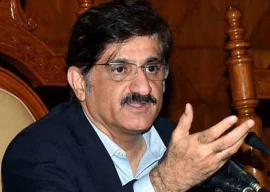
Enrolment of children at the primary level in Karachi's government schools is less than nine per cent, a survey by the Human Rights Commission of Pakistan (HRCP) has revealed.
According to the organisation, which conducts frequent surveys, the enrolment rate of primary schoolchildren was 30 per cent in 1998. In 2002-2003, the figure dropped to 26 per cent and further to 24 per cent in 2005-2006. Today (in 2014-2015), it is less than nine per cent.
Why 25 million children are out of school in Pakistan
HRCP secretary-general IA Rehman shared the findings of the latest survey at a news conference at Karachi Press Club on Friday. "It is the responsibility of the state to provide education to children," he said, stressing that standards need to be improved.
Rehman said there was no organisation or mechanism to explain where the remaining 91 per cent primary-school aged children were getting an education from: whether they were going to madrassas, private schools or were out-of-school.
Major findings
The survey revealed that there were 325,715 students enrolled in government schools in 1998, while in 2014-15 the number stood at 207,218.
The survey found out that in six districts of the city, there were 248 one-roomed schools.
Education conference: ‘290,000 children out of school in Lahore’
The highest number of enrolment is in Korangi District, followed by Central Karachi. While East district has the lowest number of schools — 300 — and lowest enrolment of 52,769 students.
Today, there are a total 3,097 government schools in Karachi, as compared to 3,302 in 2001.
There are many schools in Karachi where the number of teachers is greater than the number of students. There are some schools where the number of students is high and teachers less than the requirement.
Teachers also give a monthly bribe of Rs5,000 to ensure their daily attendance, it was noted. Moreover, 45 per cent of schools have no teachers for Maths, Science and English.
Students' woes
In 87 government schools, a survey of 110 students revealed that 45 pupils complained of teachers' behaviours, 86 informed that the school has a washroom with no water whereas 80 per cent students said there were no co-curricular activities like sports and debates.
UNICEF report: No schooling for nearly 4m children in Sindh
HRCP's Qazi Khizer Hayat said in co-education schools, the number of girls is higher, with a 60:40 ratio.
Moreover, surveyors found out that there was a shortage of non-teaching staff like peons, gatekeepers and sweepers, while there was interference of political groups as well. Multiple schools were also said to be located in the same buildings.
Sharing more data, it was revealed that around 20 per cent schools had no electricity, and 45 classrooms had no fans. Five per cent schools had washrooms but 90 per cent of them could not be used. There was also no water in 90 per cent of the toilets. Overall, 55 per cent schools had no drinking water. However, the furniture in schools was found to be in good condition.

Published in The Express Tribune, December 19th, 2015.



1732105641-0/BeFunky-collage-(78)1732105641-0-165x106.webp)



1732080054-1/Copy-of-Untitled-(48)1732080054-1-270x192.webp)









COMMENTS (4)
Comments are moderated and generally will be posted if they are on-topic and not abusive.
For more information, please see our Comments FAQ